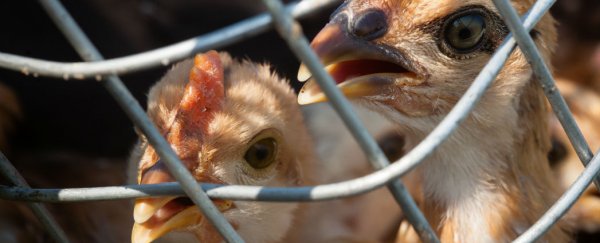With a mysterious bird flu epidemic killing millions of chickens across the American Midwest, and a deadly human pandemic only a handful of viral mutations away, any new addition to our armory of bird- flu vaccines is great news.
And now researchers in the US have described a method of developing vaccines against the H5N1 and H7N9 strains - both of which have killed hundreds of people since they first appeared, with H7N9 posing an exceptionally deadly threat to humans. The team may also be able to use this method to develop a vaccine against the deadly Midwest strain H5N2, if their current experiments are successful.
To create the vaccines, the researchers worked with a drug that had been developed to fight another avian affliction: the Newcastle Disease. First, they cloned this vaccine, and then inserted bits of genetic material from the H5N1 and H7N9 into the clone. They then administered the altered Newcastle Virus Vaccines to chickens, and the birds ended up having much greater immunity to both strains of bird flu than the control chickens that were injected with saline, the team reports in the Journal of Virology.
The potential of these new vaccines is significant, because while H7N9 is a relatively new entrant in the bird flu scene, having emerged in 2013, it's been a source of great worry to public health officials because of its ability to jump from poultry to humans. In April 2013, the World Health Organisation described H7N9 as an "unusually dangerous virus to humans and called for increased surveillance", citing the very real risk of a human pandemic. So far, H7N9 has killed over 100 people and made 300 ill, but there isn't any vaccine against it yet.
While vaccines against the other strain, H5N1, are available, the continuous mutations the virus undergoes make it no less of a concern. The good thing about this strain is that it doesn't transmit easily from person to person, but when it does, it's got a high mortality rate of 60 percent. The toll from H5N1 influenza has crossed 400 since 1997, when the strain was first isolated.
H5N2, the Midwest strain that has killed 21 million chickens and turkeys in the region so far, is not known to spread to human beings. But the longer it remains around, the greater the chances that it will mutate into something that can infect people, experts say.
Piggybacking the Newcastle disease virus to attack bird flu means the new vaccines could potentially stamp out both the diseases in chickens. "You kill two birds with one stone, metaphorically speaking," co-author Jurgen Richt, a veterinary microbiologist and the director of US Department of Homeland Security's Centre of Excellence for Emerging and Zoonotic Animal Diseases at Kansas State University in the US, said in a press release. "You use only one vector to vaccinate and protect against a selected virus strain of avian influenza." During the study, Richt and team also tested the chickens for immunity against Newcastle disease and got promising results.
The vaccines are already in production by a firm in Mexico, Richt told Hutchinson News. To introduce the vaccines in the US, the firm will have to decide whether to put them through the tests required by the US Department of Agriculture, he said. When used, these vaccines prevent birds from shedding the virus through their mouths and droppings, thus stopping transmission from one bird to another. This reduces human exposure to the virus as well. H7N9 often spreads to humans from live birds purchased in poultry markets, because the birds can look healthy even though they are infected.
The development of the vaccine is good news for livestock breeders, in general. The Newcastle disease virus vaccine had already been tested as a carrier in mice, pigs and dogs, which means it could be used to produce vaccines for diseases in more than just birds - pigs, cattle and sheep are also good candidates. The team has already tested a vaccine against an H3 influenza strain that affects pigs. Another vaccine against porcine epidemic diarrhea, which has killed 6 million pigs so far, is in the works. It's a "delivery platform that's safe" across several mammalian species, Richt told Hutchinson News.
